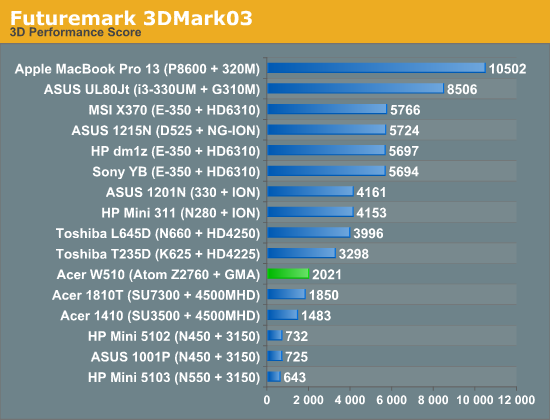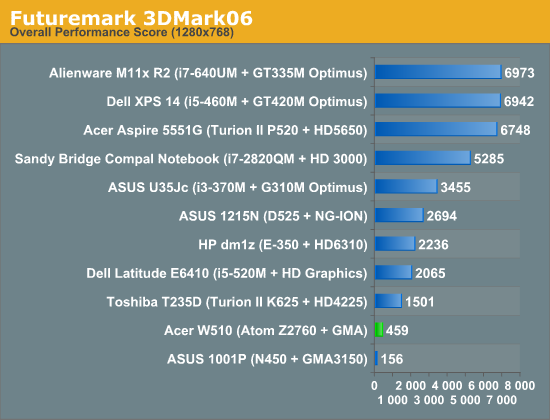The Clover Trail (Atom Z2760) Review: Acer's W510 Tested
by Anand Lal Shimpi on December 20, 2012 10:34 AM ESTGPU Performance
Contrary to popular opinion prior to its launch, the Clover Trail platform and Cloverview SoC feature a PowerVR SGX 545 GPU. The rumored PowerVR SGX 544MP2 won’t show up until Clover Trail+ next year. The SGX 545 is clocked at a fairly aggressive 533MHz.
Architecturally the 545 is very similar to the PowerVR SGX 540 used in Intel’s Medfield smartphone platform, with a handful of additions. The shader array remains unchanged at four USSE pipes. The 545 adds four more 10-bit integer pipes, doubles the triangle setup rate and doubles the number of depth test units as well. DirectX 10 class texture hardware is also a part of the mix, as well as everything else needed to officially support DirectX 10 (D3D feature level 9_3).
Compared to what’s shipping in the latest iPads however, Clover Trail is horribly under-specced. We don’t have good cross-platform (Windows RT/8) GPU tests yet, but based on what I’ve seen thus far it looks like the GPU here is a bit slower than what you get in a Tegra 3.
| Mobile SoC GPU Comparison | |||||||||||
| PowerVR SGX 545 | NVIDIA Tegra 3 | PowerVR SGX 543MP2 | PowerVR SGX 543MP4 | PowerVR SGX 554MP4 | |||||||
| Used In | Clover Trail | Tegra 3 | iPad 2/mini | iPad 3 | iPad 4 | ||||||
| SIMD Name | USSE | "core" | USSE2 | USSE2 | USSE2 | ||||||
| # of SIMDs | 4 | 12 | 8 | 16 | 32 | ||||||
| MADs per SIMD | 2 | 1 | 4 | 4 | 4 | ||||||
| Total MADs | 8 | 12 | 32 | 64 | 128 | ||||||
| GFLOPS @ 300MHz | 4.8 GFLOPS | 7.2 GFLOPS | 19.2 GFLOPS | 38.4 GFLOPS | 76.8 GFLOPS | ||||||
Looking at raw FP performance tells us a lot of the story. The 545’s high clock helps it punch above its weight, but it's still significantly less powerful than the 543MP2 used in the iPad 2/mini (and it’s nothing compared to what’s in the iPad 3/4).
Tegra 3-class GPU performance may have been acceptable a year ago running Android, but it’s just too little too late today. Since Clover Trail has full backwards compatibility with older Windows applications, I can put its GPU performance in perspective. Turning to 3DMark03 and 06, we can get a good idea of the class of performance we’re looking at. For complete (and consistent) comparison points, I've tossed the W510's results into Bench so you can compare to any notebook/mobile GPU you want to there.


Compared to the old Atom platform with Intel’s GMA 3150, the PowerVR SGX 545 based GMA is around 3x faster. Even Intel's old mobile G45 graphics are actually slightly slower. Performance is still far behind everything else modern though. The GPU is more than adequate for Modern UI acceleration, but if you have secret hopes of being able to run some of your older games on Clover Trail you’ll want to stash those dreams away.
None of this is really Imagination’s fault - Intel remains generations behind in implementing competitive GPUs in its ultra mobile SoCs. Even the jump to PowerVR SGX 544MP2 next year will happen just as Apple likely moves to Img’s Series 6 (Rogue) architecture. It’s definitely a problem if you’re a silicon company that delivers slower silicon than what your customers can put together.










104 Comments
View All Comments
BSMonitor - Thursday, December 20, 2012 - link
ExactlyNot everyone runs only prepackaged software from Best Buy.
I can write programs in Visual Studio very easily on the PC. With no recompiles, emulators, etc, I can also run that program on the x86 tablets.
Guspaz - Thursday, December 20, 2012 - link
That has nothing to do with x86 compatibility and everything to do with Win32 compatibility, and that's all on Microsoft.If Microsoft had not prevented third-party apps from using Win32 on RT devices, you'd be able to recompile most apps with no code changes for ARM.
Alexvrb - Thursday, December 20, 2012 - link
Well that would be nice for us tech heads, but opening up WinRT like Win8 brings all of the negatives too. For most of your average users, WinRT is better. You can't take it online, click some ads, and get a nice trojan or two. It's really a good tablet platform overall.So now we've got the option of some affordable Atom-based Win8 tablets. So you can pick whatever suits your needs more, WinRT (and its restrictive walls and safety) or Win8 (and all the traditional Windows advantages and disadvantages).
Chamie - Tuesday, March 5, 2013 - link
> You can't take it onlineYou can stop here, lol. (No browsers, only IE) Kidding.
But, actually, you can't get it as easy on x86 Windows too — UAC and other stuff should prevent it. The only thing preventing you from getting the same on RT will be it's lack of popularity for users and, thus, for malware makers. Even WiFi routers suffer from infections (see Psyb0t, Chuck Norris etc.) despite running Linux on MIPS, why would Windows on ARM be any safer?
Guspaz - Thursday, December 20, 2012 - link
Every single app you mentioned there runs on ARM (either the full version or a mobile tablet-oriented version) except for notepad++, and the only reason it won't run on ARM is because Microsoft forbids the use of Win32 on RT.x86 compatibility isn't all its cracked up to be. Most of the software you use on an x86 Linux distribution works just fine on an ARM Linux distribution, including stuff people tend to use on a day to day basis like Chrome or Firefox.
I think you could make a better case for Win32 compatibility, x86 compatibility doesn't mean much for most people.
SM123456 - Wednesday, February 13, 2013 - link
But this netbook costs $600. Ridiculous!Concillian - Thursday, December 20, 2012 - link
Depends entirely on what you want to run.Consider, for example automotive applications that interface with your car. These are very lightweight and old tech. A laptop in the passenger seat with a TN screen is overly bulky and the crappy screen is a liability. A tablet is a huge improvement in ergonomics.
Applications like that are NEVER getting ported to android or iOS, so x86 compatibility is the only answer. I suspect that there are a number of similar industrial applications. At my work, we have some very lightweight applications at work running homemade VB or .Net applicatoins from 1.6GHz P4 machines. With x86, we could run them, but nothing else will. Some of these were developed to run on a 486 and we still use the basic program to run the equipment.
x86 compatibility is meaningful to people who do actual work with these kinds of devices. Those who treat them like toys? Probably not so much.
Slaimus - Thursday, December 20, 2012 - link
There are many such apps for iOS and Android. They interface with a bluetooth OBD transmitter and you can wirelessly view real time information. See: https://play.google.com/store/apps/details?id=org....Concillian - Thursday, December 20, 2012 - link
I know of and have used Torque. It's a toy.It cannot do the same thing that factory diagnostic tools and open source reverse engineered equivalent tools can do (like re-programming the ECU or TCU for your desires). Those tools are specialized by vehicle brand and are (x86) Windows exclusive.
Industrial applications for these kinds of things move at a GLACIAL pace. Less than a decade ago I was regularly using a program that used a *terminal program* to communicate through a serial cable to program the device... It was straight out of the 80s... iOS and Android apps for the stuff that people make money with are not going to spring up overnight.
x86 compatibility is a must for these kinds of applications. They also happen to be applications that are VERY light on hardware, so these kinds of tablets are a good option.
lmcd - Thursday, December 20, 2012 - link
I'm sorry, but you attribute "actually doing work" to "requiring junky legacy apps?" Not every workplace is burdened with those. And most that are depend on the mouse+keyboard interface anyway, so the whole "Win 32' compatibility is irrelevant.Besides, why did you write homemade VB apps anyway? VB is VB... and .Net shouldn't be that hard to port to a new version (which, obviously, would run on RT).